
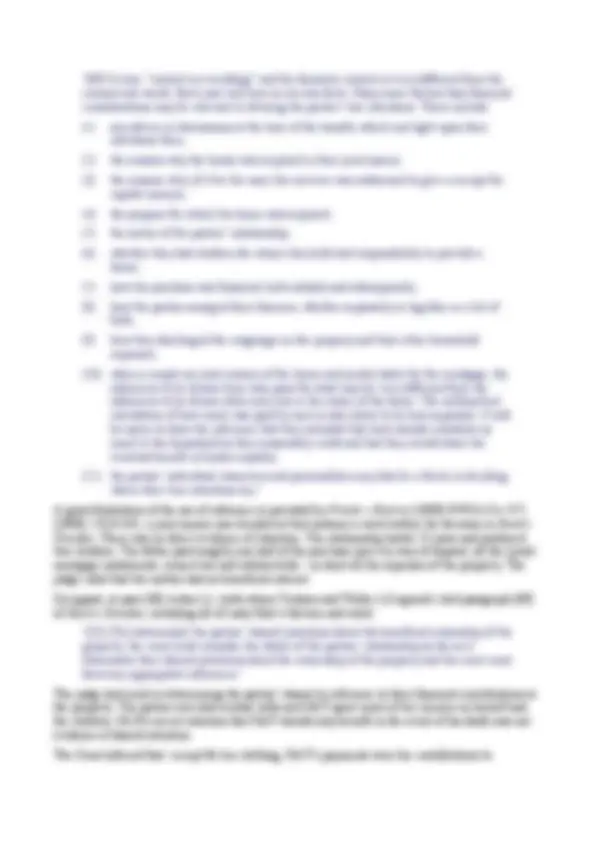
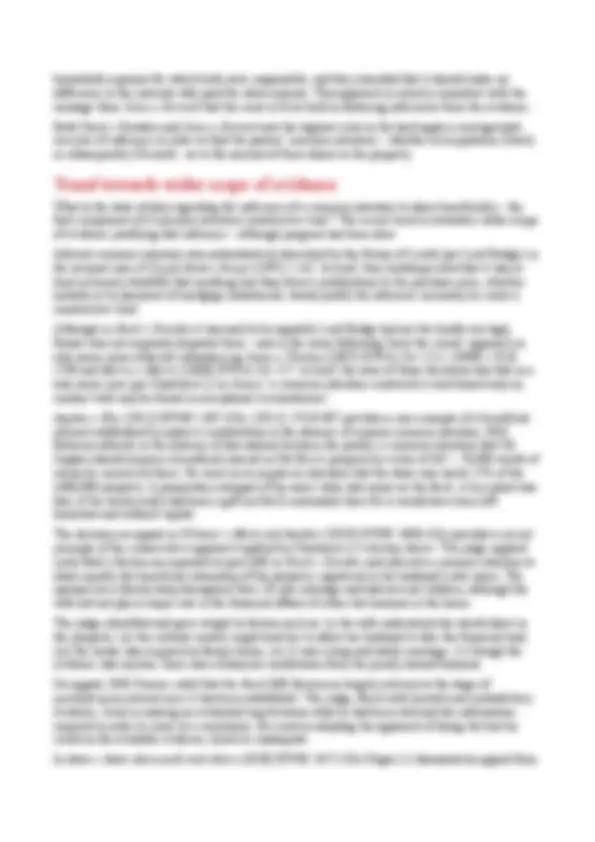
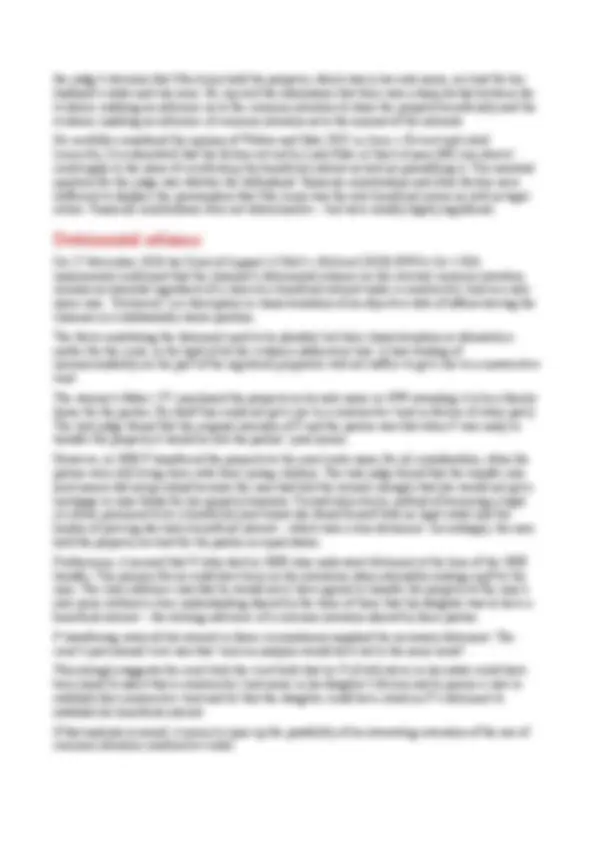
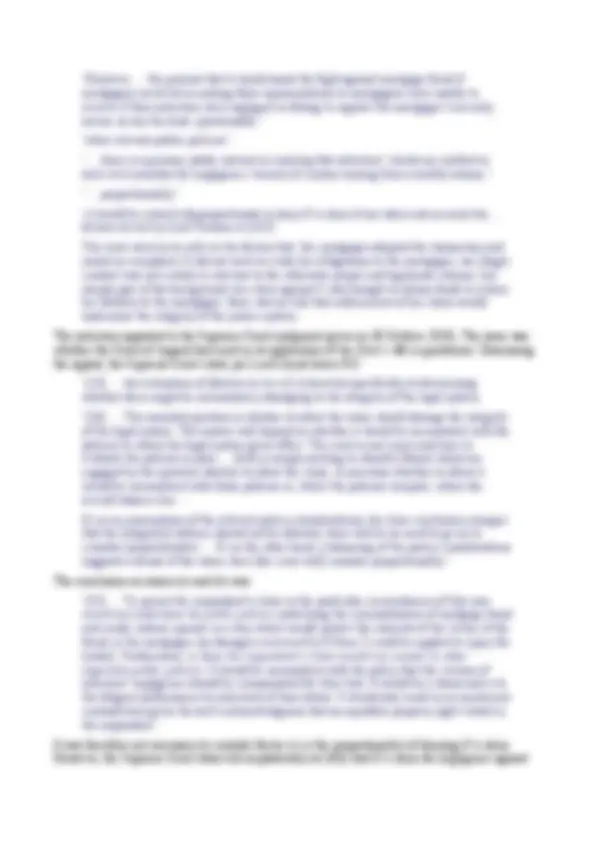
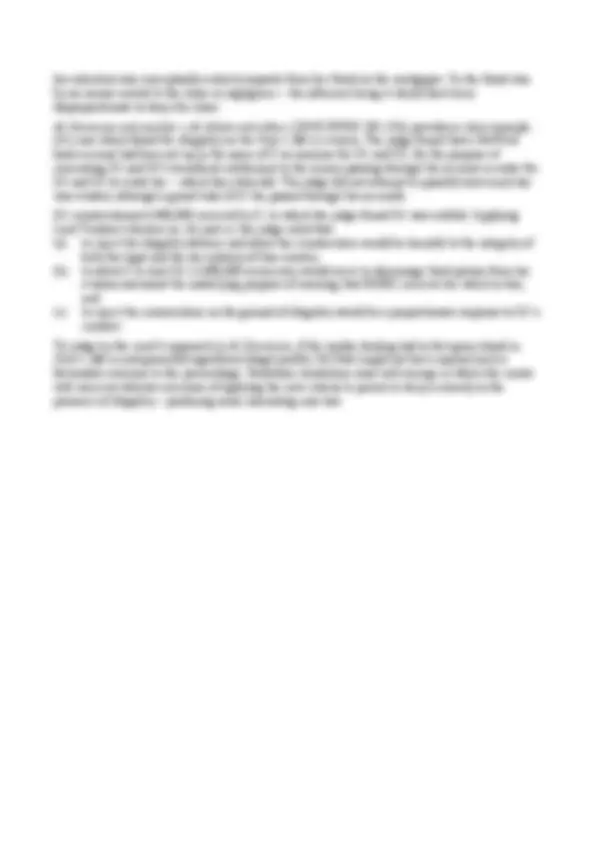


Study with the several resources on Docsity

Earn points by helping other students or get them with a premium plan


Prepare for your exams
Study with the several resources on Docsity

Earn points to download
Earn points by helping other students or get them with a premium plan
Community
Ask the community for help and clear up your study doubts
Discover the best universities in your country according to Docsity users
Free resources
Download our free guides on studying techniques, anxiety management strategies, and thesis advice from Docsity tutors
The role of inference in determining beneficial interests in property disputes, focusing on cases under the Trusts of Land and Appointment of Trustees Act 1996 (TOLATA). Topics include the use of inferred common intention constructive trusts, the impact of Patel v Mirza on illegality, and various court decisions illustrating the application of inference in property disputes.
Typology: Slides
Uploaded on 09/12/2022
1 / 9

This page cannot be seen from the preview
Don't miss anything!






APRIL 2021 k^ VOLUME 51 k^ PAGES 453–
k (^) Whither the inherent jurisdiction? How did we get here? Where are we now? Where are we going? Part III Sir James Munby
k (^) The Family Solutions Initiative – a response to a system in crisis Karen Barham , Martin Kingerley QC and Rhys Taylor
k (^) The continuing impact of the unavailability of secure accommodation Stephen Roberts
k (^) TOLATA update: (1) the use of inference and the role of detriment (2) the issue of illegality since Patel v Mirza Luke Barnes
k (^) Findings from serious case reviews during the period 1987–2018: a personal and conceptual reflection. Part I Professor Kim Holt and Professor Nancy Kelly
k (^) ADR for unmarried couples: mediation; private FDRs and arbitration Elizabeth Darlington
k (^) Without notice applications in Children Act and Family Law Act: tips, pointers and warnings Mark Ablett and Samara Brackley
k (^) Transgenderism; the law in context Professor Chris Barton
k (^) Knell sounds for the current treatment of minors for gender dysphoria Mary Welstead
Express common intention constructive trusts depend on evidence of informal writing or express discussions (no matter how imprecise their terms or how imperfectly remembered) demonstrating an arrangement, agreement or understanding to share the property beneficially. This can lead to high risk litigation, where the issue may be whether a given conversation did or did not take place, or what its precise contents were.
However, in any given sole name case there may be scope to put forward a compelling claim for a beneficial interest based on an inferred common intention constructive trust. In Jones v Kernott [2011] UKSC 53, [2012] 1 FLR 45 four members of the Supreme Court cited Lord Neuberger’s words from Stack v Dowden [2007] UKHL 17, [2007] 1 FLR 1858 – now the accepted definition of inferred and imputed intention:
‘[126] An inferred intention is one which is objectively deduced to be the subjective actual intention of the parties, in the light of their actions and statements. An imputed intention is one which is attributed to the parties, even though no such actual intention can be deduced from their actions and statements, and even though they had no such intention. Imputation involves concluding what the parties would have intended, whereas inference involves concluding what they did intend.’
It is well established that the court may not impute to the parties a common intention to share the beneficial ownership of a property – although it is entirely entitled to draw that inference. In Capehorn v Harris [2015] EWCA Civ 955, [2016] 2 FLR 1026 the district judge ‘looked at the matter in the round’ and ‘imputed’ an intention that the claimant should acquire a beneficial interest
In Jones v Kernott the majority said (per Lord Walker and Lady Hale JJSC, with whom Lord Collins JSC agreed):
‘[34] ... while the conceptual difference between inferring and imputing is clear, the difference in practice may not be so great. In this area, as in many others, the scope for inference is wide. The law recognises that a legitimate inference may not correspond to an individual’s subjective state of mind. As Lord Diplock also put it in Gissing v Gissing [1971] AC 886, 906: “… the relevant intention of each party is the intention which was reasonably understood by the other party to be manifested by that party’s words or conduct notwithstanding that he did not consciously formulate that intention in his own mind or even acted with some different intention which he did not communicate to the other party.”’
In Stack v Dowden Lady Hale set out a non-exhaustive list of factors to assist in assessing the parties’ common intention.
household expenses for which both were responsible; and they intended that it should make no difference to the interests who paid for what expense. This approach is entirely consistent with the message from Jones v Kernott that the court is to be bold in deducing inferences from the evidence.
Both Stack v Dowden and Jones v Kernott saw the highest court in the land apply a reinvigorated exercise of inference in order to find the parties’ common intention – whether on acquisition (Stack) or subsequently (Kernott) - as to the amount of their shares in the property
What is the state of play regarding the inference of a common intention to share beneficially – the first component of a common intention constructive trust? The recent trend is towards a wider scope of evidence justifying that inference – although progress has been slow.
Inferred common intention was authoritatively described by the House of Lords (per Lord Bridge) in the seminal case of Lloyds Bank v Rosset [1991] 1 AC. In brief, their lordships ruled that it was at least extremely doubtful that anything less than direct contributions to the purchase price, whether initially or by payment of mortgage instalments, would justify the inference necessary to create a constructive trust.
Although in Stack v Dowden it was said to be arguable Lord Bridge had set the hurdle too high, Rosset was not expressly departed from – and in the years following Stack the courts’ approach in sole name cases reflected orthodoxy eg James v Thomas [2007] EWCA Civ 1212, [2008] 1 FLR 1598 and Morris v Morris [2008] EWCA Civ 257. In brief, the ratio of those decisions was that in a sole name case (per Chadwick LJ in James ) ‘a common intention constructive trust based only on conduct will only be found in exceptional circumstances’.
Aspden v Elvy [2012] EWHC 1387 (Ch), [2012] 2 FLR 807 provides a rare example of a beneficial interest established by indirect contributions in the absence of express common intention. HHJ Behrens inferred, in the absence of discussions between the parties, a common intention that Mr Aspden should acquire a beneficial interest in Ms Elvy’s property by virtue of £65 – 70,000 worth of works he carried out there. He went on to impute an intention that the share was worth 25% of the £400,000 property. A proprietary estoppel of the same value also arose on the facts. A key point was that, if the works really had been a gift (as Ms E contended) then Mr A would have been left homeless and without capital.
The decision on appeal in Pillmoor v Miah and Another [2019] EWHC 3696 (Ch) provides a recent example of the conservative approach typified by Chadwick LJ’s dictum above. The judge applied Lady Hale’s factors as expressed at para [69] in Stack v Dowden and inferred a common intention to share equally the beneficial ownership of the property, registered in the husband’s sole name. The spouses ran a family shop throughout their 28 year marriage and had several children, although the wife did not play a major role in the financial affairs of either the business or the home.
The judge identified and gave weight to factors such as: (i) the wife understood she would share in the property; (ii) the cultural context might lead her to allow her husband to take the financial lead; (iii) the house was acquired as family home; (iv) it was a long and stable marriage; (v) though the evidence was unclear, there was a financial contribution from the jointly owned business.
On appeal, HHJ Kramer ruled that the Stack [69] factors are largely relevant at the stage of quantifying an interest once it has been established. The judge, faced with limited and contradictory evidence, erred in making an evidential leap between what he had been told and the information required in order to come to a conclusion. He erred in adopting the approach of doing the best he could on the available evidence, however inadequate.
In Amin v Amin (deceased) and others [2020] EWHC 2675 (Ch) Nugee LJ dismissed an appeal from
the judge’s decision that Mrs Amin held the property, which was in her sole name, on trust for her husband’s estate and two sons. He rejected the submission that there was a sharp divide between the evidence enabling an inference as to the common intention to share the property beneficially and the evidence enabling an inference of common intention as to the amount of the interests.
He carefully considered the opinion of Walker and Hale JJSC in Jones v Kernott and ruled (correctly, it is submitted) that the factors set out by Lady Hale in Stack at para [69] (see above) could apply to the issue of establishing the beneficial interest as well as quantifying it. The essential question for the judge was whether the defendants’ financial contributions and other factors were sufficient to displace the presumption that Mrs Amin was the sole beneficial owner as well as legal owner. Financial contributions were not determinative – but were usually highly significant.
On 27 November 2020 the Court of Appeal ( O’Neill v Holland [2020] EWCA Civ 1583) unanimously confirmed that the claimant’s detrimental reliance on the relevant common intention remains an essential ingredient of a claim to a beneficial interest under a constructive trust in a sole name case. ‘Detriment’ is a description or characterisation of an objective state of affairs leaving the claimant in a substantially worse position.
The facts constituting the detriment need to be pleaded, but their characterisation is ultimately a matter for the court, in the light of all the evidence adduced at trial. A bare finding of unconscionability on the part of the registered proprietor will not suffice to give rise to a constructive trust.
The woman’s father (‘F’) purchased the property in his sole name in 1999 intending it to be a family home for the parties. By itself this could not give rise to a constructive trust in favour of either party. The trial judge found that the original intention of F and the parties was that when F was ready to transfer the property it would be into the parties’ joint names.
However, in 2008 F transferred the property to the man’s sole name for nil consideration, when the parties were still living there with three young children. The trial judge found that the transfer into joint names did not go ahead because the man had told the woman wrongly that she would not get a mortgage to raise funds for his property business. Viewed objectively, instead of becoming a legal co-owner presumed to be a beneficial joint tenant she found herself with no legal estate and the burden of proving she had a beneficial interest – which was a clear detriment. Accordingly, the man held the property on trust for the parties in equal shares.
Furthermore, it seemed that F (who died in 2009) also underwent detriment at the time of the 2008 transfer. The primary focus could have been on his intentions when ostensibly making a gift to the man. The clear inference was that he would never have agreed to transfer the property to the man’s sole name without a clear understanding shared by the three of them that his daughter was to have a beneficial interest – the striking inference of a common intention shared by three parties.
F transferring away all his interest in those circumstances supplied the necessary detriment. The court’s provisional view was that ‘such an analysis would have led to the same result’.
This strongly suggests the court took the view both that (a) F (if still alive) or his estate could have been heard to assert that a constructive trust arose in his daughter’s favour and to pursue a case to establish that constructive trust and (b) that the daughter could have relied on F’s detriment to establish her beneficial interest.
If that analysis is sound, it seems to open up the possibility of an interesting extension of the use of common intention constructive trusts.
variety of cases.
He endorsed ([115]) Gloster LJ’s approach in the CA. She examined the policy underlying the statutory provisions about insider dealing and concluded there was no logical basis why public policy should require P to forfeit the money, which was paid to M, but never used for the illegal purpose. Such a result would not be a just and proportionate response to the illegality.
The decision has dramatically liberalised the law on enforcing claims tainted by illegality. However, it has now introduced a striking exercise of discretion into the law (which caused three of the nine JJSC to dissent from the reasoning of the majority) which may increase legal uncertainty. However, in the majority of domestic cases, the decision will introduce a welcome element of proportionality, and should help to prevent people from failing to obtain property rights tainted by relatively minor illegal conduct.
Patel v Mirza was followed in Kliers v Schmerler and another [2018] EWHC 1350 (Ch). C and D had been married. They purchased a property in D1’s name (he being C’s brother). C contended that she and D2 had entered a tenancy agreement with D1 and obtained up to £150,000 housing benefit (some of which may have been used to make mortgage payments). A dispute arose in which D contended that he was the true owner, not a nominee.
The judge held that the court should take account of the illegal purpose of the ownership structure (although D1 had not pleaded it) ie for D1 to obtain funds as mortgagor and from HB which he would not have been entitled to if the true situation had been disclosed.
However, C was not to be barred from relief. Firstly, she had agreed to the arrangement under undue influence from religious leaders and family (all Hasidic Jews). Secondly, on the application of Patel v Mirza and considerations of restitution and public policy. Public policy against mortgage fraud was strong but did not militate against C’s remedy in this case. D1’s reliance on C’s illegality demonstrated extreme hypocrisy and to leave matters where they stood would be to continue the perpetration of the fraud (which, it seems, was more serious than that in Tinsley v Milligan itself).
The orders and judgments of the court would be referred to the authorities and C undertook to give disclosure to them and to take steps to ensure both the mortgagee and the DWP were fully repaid out of the house – possibly by way of charges over the house for the repayment of HB on the sale by the mortgagee. To remedy the position in this regard was accepted to be an important part of C’s aim in the proceedings.
In Stoffel & Co v Grondona [2018] EWCA Civ 2031 G had instructed S in her proposed purchase of a property from her friend M. G obtained a mortgage fraudulently, in that her true intention was to obtain finance for M by misrepresentation. S negligently failed to register G’s title or the legal charge and G sued S for damages. S defended on the basis of illegality. At trial, G’s claim succeeded (on 11 April 2016) on the basis she did not need to rely on the illegality to prove her claim.
On the solicitor’s appeal, the applicable law was Patel v Mirza. On the Patel criteria, the Court of Appeal ruled:
‘underlying purpose of the prohibition transgressed’: ‘mortgage fraud … is a canker on society and it is extremely important that dishonest applicants for mortgages should not be empowered by law to abuse the system.’
‘However … the premise that it would assist the fight against mortgage fraud if mortgagors involved in making false representations to mortgagees were unable to recover if their solicitors were negligent in failing to register the mortgagee’s security seems, so say the least, questionable.’ ‘other relevant public policies’: ‘… there is a genuine public interest in ensuring that solicitors’ clients are entitled to seek civil remedies for negligence / breach of contract arising from a lawful retainer.’ ‘… proportionality’: ‘it would be entirely disproportionate to deny G’s claim if one takes into account the … factors set out by Lord Toulson at [107]’. The court went on to refer to the factors that: the mortgagee adopted the transaction and raised no complaint; G did not seek to evade her obligations to the mortgagee; her illegal conduct was not central or relevant to the otherwise proper and legitimate retainer, but simply part of the background; her claim against S was brought to obtain funds to reduce her liability to the mortgagee; there was no risk that enforcement of her claim would undermine the integrity of the justice system.
The solicitors appealed to the Supreme Court (judgment given on 30 October 2020). The issue was whether the Court of Appeal had erred in its application of the Patel v Mirza guidelines. Dismissing the appeal, the Supreme Court ruled, per Lord Lloyd-Jones JSC:
‘[23] … the evaluation of [factors (a) to (c)] is directed specifically at determining whether there might be inconsistency damaging to the integrity of the legal system. ‘[26] … The essential question is whether to allow the claim would damage the integrity of the legal system. The answer will depend on whether it would be inconsistent with the policies to which the legal system gives effect. The court is not concerned here to evaluate the policies in play … [but] is simply seeking to identify [those] which are engaged by the question whether to allow the claim, to ascertain whether to allow it would be inconsistent with those policies or, where the policies compete, where the overall balance lies. … If, on an examination of the relevant policy considerations, the clear conclusion emerges that the [illegality] defence should not be allowed, there will be no need to go on to consider proportionality … If, on the other hand, a balancing of the policy considerations suggests a denial of the claim, then [the court will] consider proportionality.’
The conclusion on issues (a) and (b) was:
‘[35] … To permit the respondent’s claim in the particular circumstances of this case would not undermine the public policies underlying the criminalisation of mortgage fraud and could, indeed, operate in a way which would protect the interests of the victim of the fraud, ie the mortgagee [as damages recovered by G from S could be applied to repay the lender]. Furthermore, to deny the respondent’s claim would run counter to other important public policies. It would be inconsistent with the policy that the victims of solicitors’ negligence should be compensated for their loss. It would be a disincentive to the diligent performance by solicitors of their duties. It would also result in an incoherent contradiction given the law’s acknowledgment that an equitable property right vested in the respondent.’
It was therefore not necessary to consider factor (c) ie the proportionality of denying G’s claim. However, the Supreme Court observed emphatically (at [43)] that G’s claim for negligence against